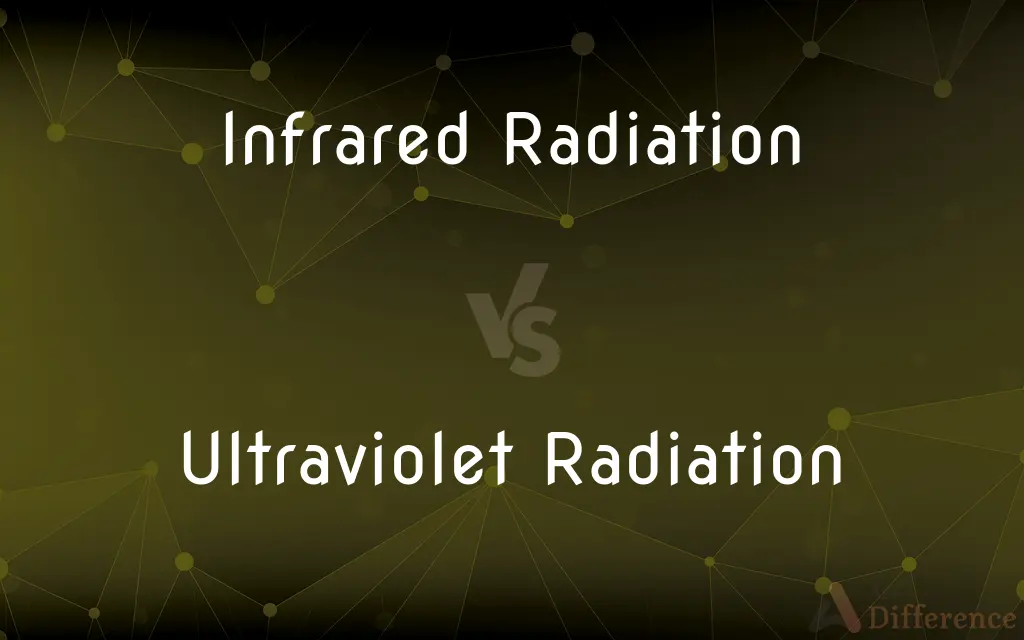Infrared Radiation vs. Ultraviolet Radiation — What's the Difference?
By Tayyaba Rehman — Published on January 10, 2024
Infrared radiation is electromagnetic radiation with wavelengths longer than visible light, often associated with heat, while ultraviolet radiation has shorter wavelengths and higher energy, known for its effect on skin.

Difference Between Infrared Radiation and Ultraviolet Radiation
Table of Contents
ADVERTISEMENT
Key Differences
Infrared Radiation (IR) is part of the electromagnetic spectrum with wavelengths longer than visible light but shorter than radio waves, typically ranging from 0.7 micrometers to 1 millimeter. It is often associated with heat, as objects at room temperature emit radiation mostly in the infrared spectrum. Ultraviolet Radiation (UV), on the other hand, has shorter wavelengths than visible light, ranging from 10 nanometers to 400 nanometers, and carries more energy than infrared light.
Infrared radiation is commonly used in various applications such as remote controls, night-vision equipment, and thermal imaging. It is also essential in scientific research, astronomy, and environmental monitoring. Ultraviolet radiation is used in sterilization, fluorescence, and in the medical field for treating certain skin conditions. It's also important in the study of astronomy and chemistry.
The biological effects of IR and UV radiation differ significantly. Infrared radiation is primarily felt as heat and is essential for warmth and thermal regulation. Prolonged exposure to intense IR can cause thermal burns. Ultraviolet radiation, especially UV-B and UV-C, can damage the DNA in living cells, leading to skin aging, sunburn, and an increased risk of skin cancer.
The Earth's atmosphere interacts differently with these types of radiation. The atmosphere is transparent to certain bands of IR, which plays a role in the Earth's heat balance. In contrast, the ozone layer in the atmosphere absorbs most of the harmful UV radiation before it reaches the Earth's surface, protecting living organisms.
Infrared radiation is emitted by all objects based on their temperature, making it a universal phenomenon. Ultraviolet radiation is mainly emitted by high-energy sources like the Sun and artificial sources like UV lamps. While both types of radiation are invisible to the naked eye, their effects are widely felt and utilized.
ADVERTISEMENT
Comparison Chart
Wavelength Range
0.7 micrometers to 1 millimeter
10 nanometers to 400 nanometers
Common Sources
Warm objects, sun, electronic devices
Sun, UV lamps
Primary Effects
Heat, thermal imaging
Skin damage, sterilization, fluorescence
Biological Impact
Mostly heat absorption, thermal burns
DNA damage, skin aging, cancer risk
Atmospheric Interaction
Partially absorbed and emitted by the Earth's surface
Mostly absorbed by the ozone layer
Compare with Definitions
Infrared Radiation
Longer wavelengths
Infrared radiation has longer wavelengths than visible light.
Ultraviolet Radiation
Sunlight component
Ultraviolet radiation from the sun causes sunburn.
Infrared Radiation
Remote control signals
Most TV remotes use infrared radiation to communicate.
Ultraviolet Radiation
Fluorescence
Certain substances fluoresce under ultraviolet radiation.
Infrared Radiation
Thermal imaging
Thermal imaging devices detect infrared radiation emitted by objects.
Ultraviolet Radiation
Skin damage
Excessive exposure to ultraviolet radiation can damage skin.
Infrared Radiation
Heat radiation
Infrared radiation is used in thermal cameras to detect heat.
Ultraviolet Radiation
Sterilization
UV radiation is used to sterilize medical equipment.
Infrared Radiation
Night vision
Infrared radiation allows night vision goggles to work in darkness.
Ultraviolet Radiation
Shorter wavelengths
Ultraviolet radiation has shorter wavelengths than visible light.
Common Curiosities
Can infrared radiation be seen by humans?
No, it's beyond the visible spectrum for humans.
Does glass block UV radiation?
Most types of glass block UV-B but not UV-A radiation.
Is UV radiation always harmful?
High exposure is harmful, but it's also essential for Vitamin D synthesis.
Can UV radiation treat skin conditions?
Yes, conditions like psoriasis can be treated with controlled UV exposure.
Do all objects emit infrared radiation?
Yes, all objects emit IR based on their temperature.
Are IR cameras used by firefighters?
Yes, for seeing through smoke and detecting heat sources.
Is UV radiation visible to some animals?
Yes, some insects and birds can see UV light.
Is IR radiation used in food processing?
Yes, for drying and roasting processes.
Is infrared used in health treatments?
Yes, for muscle relaxation and improving circulation.
Is infrared radiation used in astronomy?
Yes, to observe celestial objects not visible in regular light.
Are infrared heaters energy-efficient?
Yes, they directly heat objects and not the air.
Does UV radiation cause fading in materials?
Yes, it can cause fading and degradation of materials.
Can UV light purify water?
Yes, it's used in water purification systems to kill microbes.
Can sunscreen block all UV radiation?
It can block or absorb most UV-B and some UV-A radiation.
Is there infrared radiation from the sun?
Yes, the sun emits a significant amount of infrared radiation.
Share Your Discovery

Previous Comparison
URL vs. IP Address
Next Comparison
Double Entry System vs. Double Account SystemAuthor Spotlight
Written by
Tayyaba RehmanTayyaba Rehman is a distinguished writer, currently serving as a primary contributor to askdifference.com. As a researcher in semantics and etymology, Tayyaba's passion for the complexity of languages and their distinctions has found a perfect home on the platform. Tayyaba delves into the intricacies of language, distinguishing between commonly confused words and phrases, thereby providing clarity for readers worldwide.
















































